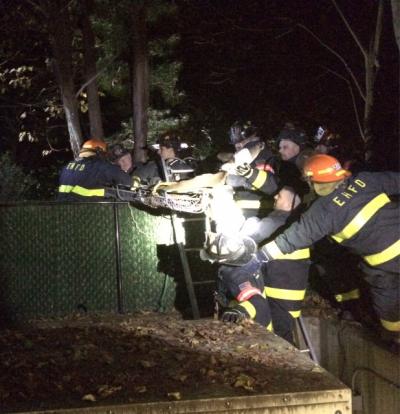Deer Rescued in East Hampton
Deer Rescued in East Hampton

Volunteer firefighters on Thursday helped remove a live deer that had been trapped in a generator pit on an East Hampton Village property.
A large doe was found in the 10-foot-deep hole, according to Cheryl Steinhauer at the Evelyn Alexander Wildlife Rescue Center in Hampton Bays, which was called by police at around 6:45 p.m. Police also called in the East Hampton Fire Department to help remove the deer, which did not appear to be injured, out of the pit.
Officials declined to identify the property's owner, but tax records indicated that it belonged to the director Steven Spielberg.
Volunteers with the wildlife center arrived quickly. Mickey and Jeannette Caputo of Springs brought a tranquilizer gun, and Ms. Caputo successfully darted the doe. However, the doe "still did not fully succumb to the sedation," so it could be lifted out of the hole, the rescuers said.
The Caputos went into the pit to cover the doe with a quilt and administer more tranquilizer, and then Mr. Caputo and Chris Plock of East Hampton bound its legs and gauze covered its eyes with gauze. Betty Lou Fletcher and Molly Plock were also among the volunteers.
"All the while the East Hampton Fire Department was waiting patiently for her to be ready to be lifted out of the hole," Ms. Steinhauer said. The firefighters lowered two ladders into the pit, followed by a Stokes basket, a plastic litter typically used to move patients in rescue operations. The doe, which weighed about 130 to 150 pounds, was strapped in and they lifted it out.
East Hampton Fire Chief Richard Osterberg Jr. said Monday that after the deer was hit with the tranquilizers it took about 15 to 20 minutes to remove it from the pit, which was about 10 to 15 feet wide and 20 feet long. They used ropes and passed the basket from one firefighter to the next to get her up and out, he said. About 30 firefighters from the department's heavy rescue squad and the Hook & Ladder engine company were there.
"She was not fully asleep and one of the firefighters held her head to steady it," Ms. Steinhauer said. "After a couple of small hiccups, they were able to lift her over the ladders and release her. She immediately staggered away."
"It was something we had never done before," Chief Osterberg said, adding that they have occasionally been called when deer get stuck in fences or in pools.
Ms. Steinhauer said her organization was happy the police called them in instead of shooting the deer. "It was heartwarming for me that they waited for us," she said.
On Monday morning, a deer was found caught in a metal fence at 75 Woods Lane. Tax records show that property is owned by Lisa M. Jordan and Thomas F. Helms Jr. The wildlife center volunteers cut it out of the fence, and it ran off, Ms. Steinhauer said. "She could have been severely injured if she had tried to get out of the fence, or if it had taken longer for us to get there to help her," she said.




